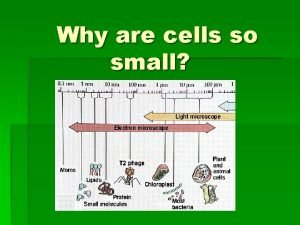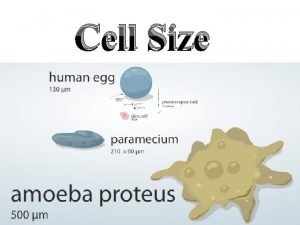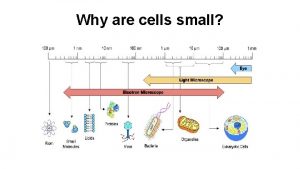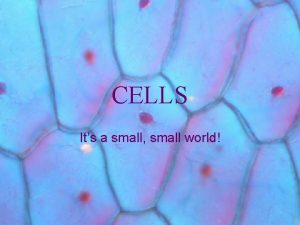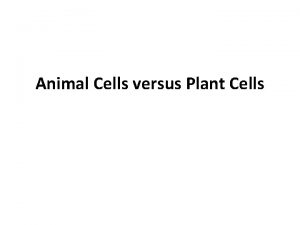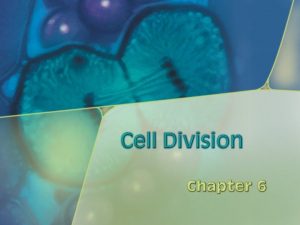Why are cells so small 1 Cells HAVE















- Slides: 15

Why are cells so small?

1. Cells HAVE to be small to be efficient I. ) What limits the size of a cell? § Most living cells are between 2 to 200 um in diameter § Ex- if the cell size doubles it would need 8 x more nutrients to survive and it would create 8 x the waste to excrete!! § WHY? Let’s do the math…

Surface Area to Volume Ratio § The vol. increases faster than the surface area of the cell membrane!! §Need a proper Surface Area: Volume ratio to support the needs of the cell

2. Rate of Diffusion § Remember the function of the cell membrane? § allows nutrients (ex. Glucose, oxygen, etc. ) in and wastes out (diffusion) § Diffusion works better over short distances (agar lab)

Diffusion 1. Diffusion: movement of particles from high to low concentration across the membrane § Very fast & efficient over short distances § Becomes slow & inefficient as the distances become larger § Organisms would die before nutrients could reach the organelles if the cell was too big

3. Need enough DNA to support protein needs of cell DNA codes for making______ § there needs to be enough DNA to support the protein needs of the cell ex. Think about how much protein is in the cell membrane -if the cell size increases, you will need more protein!

DNA 1. There’s a limit as to how fast DNA can code for proteins in nucleus and then made into proteins in the ER 2. Cell cannot survive unless there is enough DNA to support the protein needs of the cell

Surface area – to – volume ratio (Fig 8. 9) 1. As cell size increases, its volume increases much faster than surface area 2. Example: If cell size doubles, cell would require 8 x more nutrients, but the membrane would only increase by 4 x. This would mean that cell doesn’t have enough room to diffuse

Solving the problem § Bigger cells have a greater metabolism than smaller cells § BUT bigger cells have a proportionally less surface for exchange § How to increase surface area with increasing size? © 2007 Paul Billiet ODWS

Throw out extensions Microvilli of small intestine epithelium © copyright 2001 Gwen V. Childs, Ph. D. , University of Arkansas for Medical Sciences

Flatten into a thin film © Developmental Biology Online Chick blastodisc

Divide the cytoplasm into smaller volumes 8 -cell Embryo Early human embryos Zygote © Reproductive Medicine and Fertility Center

Multicellular organisms show the same adaptations § Flowering plants have an extensive, branched rooting system to absorb water and minerals © Text 2007 Paul Billiet ODWS © Illinois Enviromental Protection Agency

Multicellular organisms show the same adaptations § Mammals have a long small intestine with internal folding to absorb digested food © Text 2007 Paul Billiet ODWS lithograph plate 20 th U. S. edition of Gray's Anatomy of the Human Body, originally published in 1918. This image is in the public domain because its copyright has expired

 Mikael ferm
Mikael ferm Pictures
Pictures Why are cells so small
Why are cells so small How small are cells
How small are cells The organelle trail
The organelle trail Why do i have small balls
Why do i have small balls 8 vertices 12 edges 6 faces
8 vertices 12 edges 6 faces Dont ask
Dont ask Waters view with open mouth
Waters view with open mouth Tubular lumen
Tubular lumen Thyroid gland
Thyroid gland Gamete vs somatic cell
Gamete vs somatic cell Why dna is more stable than rna
Why dna is more stable than rna Chlorocruorin
Chlorocruorin Eukarya
Eukarya Comparing plant and animal cells venn diagram
Comparing plant and animal cells venn diagram


